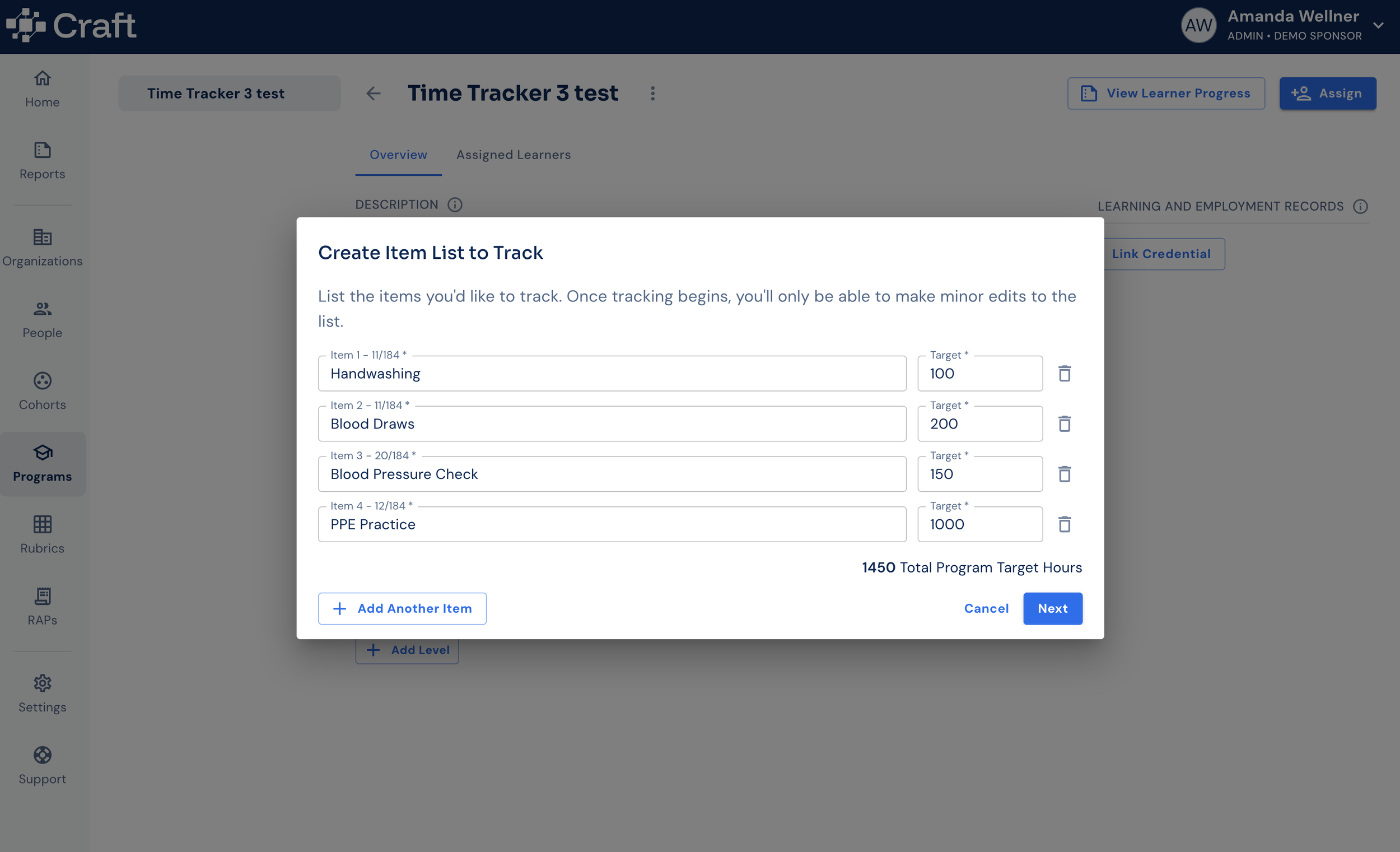Time Tracking
Replacing rigid hierarchies with flexible modules
Project Overview
Company
Craft Education (a WGU Company) is a workforce education platform currently serving teaching, healthcare, automotive, and government apprenticeship programs.
My Role
Lead UX Designer, sole IC supporting 3 product teams. Led discovery, design, and cross-functional collaboration. Established modular design patterns now scaling across features.
The Challenge
Time-based and hybrid programs had no efficient way to track hours. Admins created workarounds using individual activities, forcing learners to navigate complex hierarchies while manually calculating progress in spreadsheets. No targets, no cumulative tracking, no visibility into completion. This cumbersome process blocked customers from signing on to Craft until the tool was built.
Understanding the Landscape
Working under tight deadlines, I prioritized rapid validation:
Competitive analysis of apprenticeship tracking tools
Customer interviews revealing specific pain points with the activity-based workaround
Usability testing with admins to gut check the MVP
Cross-team pattern validation to ensure the module concept would scale
The Journey
Customer feedback revealed this wasn't just a time tracking problem; it was a structural one. Our rigid hierarchy worked for some programs but created friction for others. I proposed and designed a modular architecture where Admins could build their own programs using the modules they need by:
Validating that setup complexity and lack of proper reporting were blocking immediate customers.
Using Time Tracking as the first module to prove the concept (3-month timeline)
Partnering with engineering to scope MVP within technical constraints.
Conducting validation testing with waiting customers and internal team members.
Scaling the pattern to Absence Tracking and Skills Observation Tracking modules.
From Insight to Innovation
Through customer interviews and testing, concrete challenges emerged:
Current Craft platform setup was cumbersome - Admins spent hours creating individual activities for each tracking category, then teaching learners where to find them in the navigation.
Manual math created errors - Users tracked totals in spreadsheets because the platform couldn't aggregate hours or show progress toward targets.
No visibility into completion - Learners and admins couldn't see at a glance how close they were to required hours, making it difficult to stay on track.
Admins needed to enter data - Many entered hours on behalf of learners due to LMS integration gaps, tool vetting processes, trust issues or not wanting learners to have to log into another tool.
Approval workflows were mandatory - Department of Labor compliance requires evaluator sign off with 5-year record retention of the data and minimum hour verification.
The Transformation
Working within constraints (MUI library, 3-month deadline, existing architecture), I designed:
Modular architecture:
Programs add Time Tracking as a purpose-built module separate from the Levels/Plans/Activities hierarchy.
Multiple modules can coexist. Healthcare programs use both Time Tracking and Skills Observation.
Core workflows:
Setup: Admins create tracking items with target hours, choose daily/monthly entry, and assign to learners.
Entry: Learners log hours against items from their program page, submit for approval.
Approval: Evaluators review with focused mode (step-through interface), approve/return with comments.
Progress: Visual bars show completion toward targets, eliminating manual spreadsheet math.
Strategic cuts:
Shipped daily/monthly entry (weekly was too complex so we are observing patterns first, then improving as we hear feedback).
Used our design library components (skinned MUI components) for speed.
Moved admin-on-behalf-of-learner entry to fast-follow after validation.
Planned phase 2: filtering, dedicated pages, and responsive optimization.
Outcomes & Future Impact
Impact:
Sales successfully signed on four customers who can now build a program and onboard their learners for winter/spring semester using the time tracker.
Eliminated manual spreadsheet tracking and reduced administrative overhead.
Created a reusable pattern scaled to Absence Tracking and Skills Observation Tracking
Opened the platform up to healthcare, automotive, and government markets (80% of prospective customer base).
Allowed for more robust reporting.
Metrics we are actively tracking:
Admin setup completion rates (can they configure without support?).
Learner entry frequency and evaluator approval speed.
Adoption rates across programs and learner volume.
DataDog session recordings revealing optimization opportunities.
The modular architecture transforms how we serve diverse apprenticeship models. As usage patterns emerge, we'll refine the experience. Dedicated module pages, advanced filtering, and enhanced mobile support are next.





